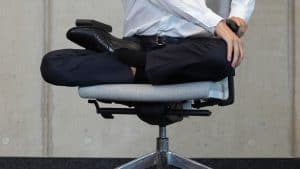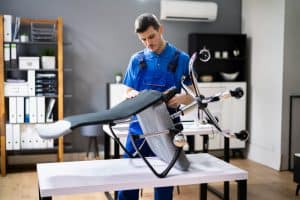Have you ever had to google, “office chair repairs near me” because your office chair keeps sinking? Many people think that it is because of the seat being loose or the cushion itself being compressed from use, but that is rarely the case. The chair won’t sink because of that.
To begin with, let’s talk about the two technologies your office chairs could have used if they are height adjustable: pneumatic and hydraulic. The difference is the use of the mediums used to make the core function work.
Pneumatic and hydraulics both are basically applications of fluid power. They are not only used in your office chairs, but also in many heavy pieces of machinery. The pneumatic system uses compressible gases in the application–air or a suitable pure gas. The hydraulic system uses incompressible liquid in its application–oil.
While hydraulics is capable of moving heavier loads and also provides a greater force, pneumatic is a much cleaner technology. Many chairs nowadays use pneumatics because they don’t need to move heavy loads, and also the oil or hydraulic fluid leak chances are negated. This makes the pneumatic systems easy and safe to store, which is a must in daily use.
Table of Content
How-does-an-office-chair-mechanism-work?
How-does-a-hydraulic-chair-work?
What-are-the-parts-of-an-office-chair?
What-to-do-when-your-seat-starts-sinking?
How does an office chair mechanism work?

We will talk about the ‘pneumatic’ here because that is what is usually used nowadays, but I do have a section next about the working of the hydraulic systems in chairs.
Many components make up the pneumatic office chair mechanism, like:
- The base (3, 4, or 5 wheels)
- A gas cylinder (stores the compressed air)
- A seat plate (has the lever to control the height adjustment)
- Padded back support
How it works:
- A single-acting cylinder is used in the pneumatic system; it is a spring filled with air. This spring is called the “gas spring,” which consists of a piston-cylinder arrangement.
- The cylinder base is covered in oil to prevent the escape of gas (commonly nitrogen), which is trapped inside the cylinder.
- The air chamber is connected to the piston.
- When you push the lever, you basically activate the piston, which then moves into the air chamber.
- The air inside the air chamber is further compressed, as a result of the piston moving into the chamber. This results in the lifting motion, and this is what allows us to raise the seat.
- When you lower the lever, the piston is moved out of the chamber, and that expands the air inside the chamber, which in turn allows you to lower your seat.
How does a hydraulic chair work?

The working is basically the same as discussed above. A hydraulic drive and fluid control system is used for the mechanism to work. The mechanism has at least two fluid actuated cylinders, and this includes a bi-directional motor pump.
Let’s look at how the patent for the hydraulic chair lift mechanism talks about the working:
The components:
- A base member
- An expandable first hollow chamber supported on the base with a flexible diaphragm wall and completely filled with a substantially incompressible liquid
- A seat to support
- A second hollow chamber containing a liquid and a pressurized gas
- An interconnecting hollow conduit connecting both the chambers
- A lever or control of sorts
How it works:
- We basically have a pair of sealed chambers that are interconnected with a hollow conduit (pipe). This contains hydraulic fluid.
- One of the chambers in this mechanism is expandable, and it comprises flexible walls in the form of a rolling diaphragm. A rolling diaphragm is basically a ductile fluid control tool, which is used to secure a perfect seal in any system that involves a piston and cylinder.
- In addition to the hydraulic fluid, the second chamber contains a pressurized gas.
- The expandable chamber is located in the supporting base of the chair.
- The interconnecting conduit that is used for fluid transfer between the chambers is fitted with a two-speed valve. It transfers the fluid at one rate in one direction and at a second rate in the other direction.
- Now, as the fluid is being transferred to the expandable chamber, a support column is forced upwards by the expanding chamber at a fast rate. When the fluid transfers from the expandable chamber to the second chamber, the support column move downwards at a second rate of speed slower than the first-rate. (Basically, the way the piston works in the pneumatic, we talked about earlier, if you are confused.)
No products found.
What are the parts of an office chair?
The construction of office chairs or desk chairs is mechanically more complex compared to other chairs. The basic deduction of the construction of an office chair can be made as two parts. The two main portions are what complete the chair: the seat and the base.
Let’s talk about both the portions and what they consist of:
The Seat Portion
- Seat: The part where you sit, which is usually cushioned, and the padding can be chosen to suit your comfort. There is seat depth and seat pan width to consider.
- Backrest: Backrest is one of the important additions to your chair because it supports your spine and helps reduce pain from sitting too long. This can and should include lumbar support, which is usually in-built, but you can get an adjustable one also.
- Tilt adjustment: The tilt adjustment mechanism allows you to lock your chair in different angles to support your sitting position. You can tilt it mostly backward, although good quality chairs will have forward tilt as well.
- Tilt tension control: A good tilt-tension control will help you adjust the tilt with ease and help you lock it in different angles rather than the set ones.
- Headrest: Headrest is something that most chairs compromise with, but a lot come with in-built ones. The adjustable ones are the best because you can adjust the height as well as the angle to get the best support and comfort possible.
- Armrests: Armrests provide great support to your wrists during long hours. Adjustable armrests make it even better. They can move up and down and pivot in and out to adjust to your sitting position. Not all armrests have cushions, but some amount of cushioning on armrests is important for comfort.
Read: How to Choose an Office Chair
The Base Portion:
- Base: The base of an office chair is usually a spiderweb-like design to provide stable support to the chair with multiple prongs. This helps with weight distribution.
- Caster Wheels: Most office chairs will have wheels to make maneuvering easier.
- Swivel: This enables your office chair to spin 360°.
- Arm: The arms are what connect the base to the bottom of the seat, so they count here as well.
- Pneumatic Cylinder: As we talked about earlier, the pneumatic cylinder is what makes your chair height adjustable and is part of the base of your chair.
- Spindle: Spindle attaches the pneumatic cylinder to the base.
What to do when your seat starts sinking?
Oiling
Pay attention to functioning. Does the mechanism function smoothly when you manipulate the lever, or does it have issues? If so, oiling the joints will help it function smoother. You may need to clean the chair cylinder first.
PVC Pipe
- Slide the plastic tube from the extendable cylinder, so that you can see the metal cylinder underneath. Now measure the cylinder – length, width, circumference.
- Get a PVC pipe of the correct length. The diameter should be the same or a bit larger.
- Cut the pipe from one opening to the other on one side using a hacksaw so that you can slide it on the cylinder. You can even remove the wheelbase and slide the PVC pipe without cutting it.
Your sinking office chair will now stop sinking. You may need to add or remove the length of the pipe to adjust the height. wikiHow has a good tutorial for the repairs to office chairs: PVC pipes and hose clamps.
A Hose Clamp
- Slide the plastic tube from the extendable cylinder, so that you can see the metal cylinder underneath.
- Clean the metal cylinder.
- You will have to decide what height you want your chair to stay at because this method does not allow your chair to be height adjustable later.
- To give your hose clamp a better grip, you can wrap a strip of rubber or a few layers of duct tape or scuff the area of the cylinder with sandpaper.
- Wrap a ¾” (2 cm) hose clamp around the cylinder – Loosen the screw on the hose clamp and then pull out the belt end. You have to then wrap the clamp around the metal cylinder. Tighten it and slide it to the top of the cylinder.
Replace the Pneumatic Cylinder
The other thing is that you might have to replace the pneumatic spring or the cylinder itself because it does wear out over the years. You can follow the manufacturer’s direction to replace it yourself, or you can take it to an authorized dealer to do it for you.
Purchasing is the easy part. Removing the chair cylinder can be difficult because the manufacturers have different ways of attaching them, and some can prove to be tiresome.
Note: You might think that because the parts are getting loose, you can tighten them or DIY a stronger hold with some bolts, but DO NOT do that. The cylinder contains pressurized gas, and if you drill into the cylinder, the puncture can cause the air to release violently.
Our Recommended Product.
- Buzz2 fabric is 100% polyester
- Wheels for carpet flooring
- Ergonomic chair – features include adjustable seat depth, fully adjustable arms, height adjustable lumbar, lower back firmness control,...
Conclusion
If your office chair keeps sinking, then first check if the external mechanism needs cleaning or oiling. Sometimes it can be as simple as that.
If that is not the issue, then you might have to replace the pneumatic cylinder or the spring that helps with the height adjustment of your chair. As discussed above, the cylinders and springs can wear out over the years. This can be done by yourself to fix a sinking office chair, but if the mechanism seems complicated, then you are better off taking it to the specialist.
I hope you understood how the height adjustment mechanism works in your office chair, and this makes you feel more confident in figuring out what is wrong with your office chair and why it keeps sinking. Let me know if you have any other questions, and I will try to solve it. See you around!





